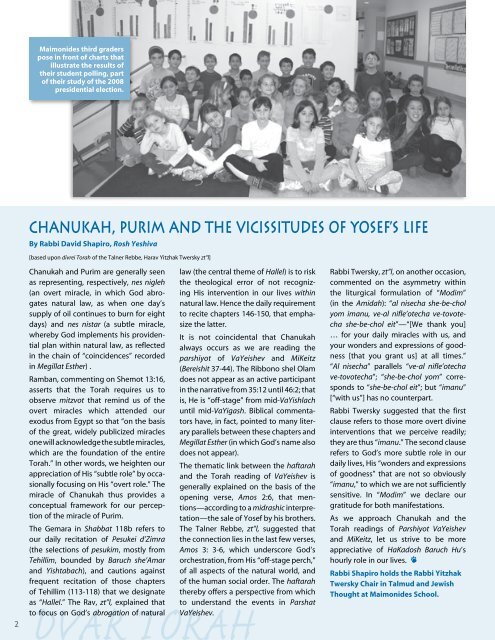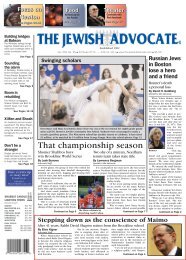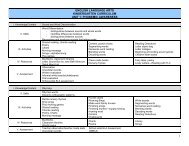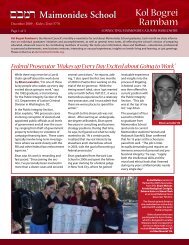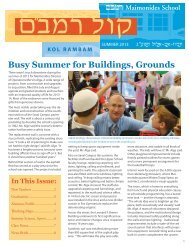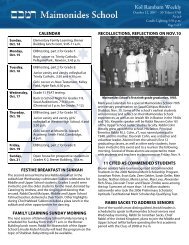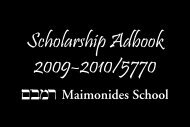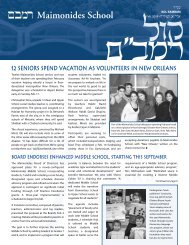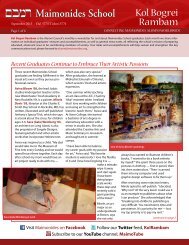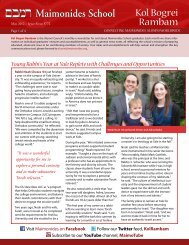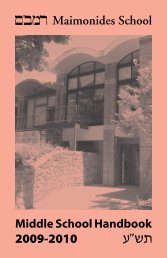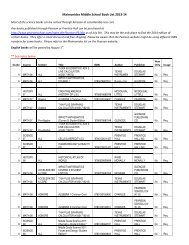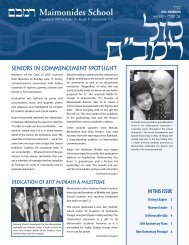Winter 2008/09 - Kislev 5769 - Maimonides School
Winter 2008/09 - Kislev 5769 - Maimonides School
Winter 2008/09 - Kislev 5769 - Maimonides School
Create successful ePaper yourself
Turn your PDF publications into a flip-book with our unique Google optimized e-Paper software.
<strong>Maimonides</strong> third graders<br />
pose in front of charts that<br />
illustrate the results of<br />
their student polling, part<br />
of their study of the <strong>2008</strong><br />
presidential election.<br />
CHANUKAH, PURIM AND THE VICISSITUDES OF YOSEF’S LIFE<br />
By Rabbi David Shapiro, Rosh Yeshiva<br />
[based upon divrei Torah of the Talner Rebbe, Harav Yitzhak Twersky zt”l]<br />
Chanukah and Purim are generally seen<br />
as representing, respectively, nes nigleh<br />
(an overt miracle, in which God abrogates<br />
natural law, as when one day’s<br />
supply of oil continues to burn for eight<br />
days) and nes nistar (a subtle miracle,<br />
whereby God implements his providential<br />
plan within natural law, as reflected<br />
in the chain of “coincidences” recorded<br />
in Megillat Esther) .<br />
Ramban, commenting on Shemot 13:16,<br />
asserts that the Torah requires us to<br />
observe mitzvot that remind us of the<br />
overt miracles which attended our<br />
exodus from Egypt so that “on the basis<br />
of the great, widely publicized miracles<br />
one will acknowledge the subtle miracles,<br />
which are the foundation of the entire<br />
Torah.” In other words, we heighten our<br />
appreciation of His “subtle role” by occasionally<br />
focusing on His “overt role.” The<br />
miracle of Chanukah thus provides a<br />
conceptual framework for our perception<br />
of the miracle of Purim.<br />
The Gemara in Shabbat 118b refers to<br />
our daily recitation of Pesukei d’Zimra<br />
(the selections of pesukim, mostly from<br />
Tehillim, bounded by Baruch she’Amar<br />
and Yishtabach), and cautions against<br />
frequent recitation of those chapters<br />
of Tehillim (113-118) that we designate<br />
as “Hallel.” The Rav, zt”l, explained that<br />
to focus on God’s abrogation of natural<br />
law (the central theme of Hallel) is to risk<br />
the theological error of not recognizing<br />
His intervention in our lives within<br />
natural law. Hence the daily requirement<br />
to recite chapters 146-150, that emphasize<br />
the latter.<br />
It is not coincidental that Chanukah<br />
always occurs as we are reading the<br />
parshiyot of VaYeishev and MiKeitz<br />
(Bereishit 37-44). The Ribbono shel Olam<br />
does not appear as an active participant<br />
in the narrative from 35:12 until 46:2; that<br />
is, He is “off-stage” from mid-VaYishlach<br />
until mid-VaYigash. Biblical commentators<br />
have, in fact, pointed to many literary<br />
parallels between these chapters and<br />
Megillat Esther (in which God’s name also<br />
does not appear).<br />
The thematic link between the haftarah<br />
and the Torah reading of VaYeishev is<br />
generally explained on the basis of the<br />
opening verse, Amos 2:6, that mentions—according<br />
to a midrashic interpretation—the<br />
sale of Yosef by his brothers.<br />
The Talner Rebbe, zt”l, suggested that<br />
the connection lies in the last few verses,<br />
Amos 3: 3-6, which underscore God’s<br />
orchestration, from His “off-stage perch,”<br />
of all aspects of the natural world, and<br />
of the human social order. The haftarah<br />
thereby offers a perspective from which<br />
to understand the events in Parshat<br />
VaYeishev.<br />
DVAR TORAH<br />
Rabbi Twersky, zt”l, on another occasion,<br />
commented on the asymmetry within<br />
the liturgical formulation of “Modim”<br />
(in the Amidah): “al nisecha she-be-chol<br />
yom imanu, ve-al nifle’otecha ve-tovotecha<br />
she-be-chol eit”—“[We thank you]<br />
… for your daily miracles with us, and<br />
your wonders and expressions of goodness<br />
[that you grant us] at all times.”<br />
“Al nisecha” parallels “ve-al nifle’otecha<br />
ve-tovotecha”; “she-be-chol yom” corresponds<br />
to “she-be-chol eit”; but “imanu”<br />
[“with us”] has no counterpart.<br />
Rabbi Twersky suggested that the first<br />
clause refers to those more overt divine<br />
interventions that we perceive readily;<br />
they are thus “imanu.” The second clause<br />
refers to God’s more subtle role in our<br />
daily lives, His “wonders and expressions<br />
of goodness” that are not so obviously<br />
“imanu,” to which we are not sufficiently<br />
sensitive. In “Modim” we declare our<br />
gratitude for both manifestations.<br />
As we approach Chanukah and the<br />
Torah readings of Parshiyot VaYeishev<br />
and MiKeitz, let us strive to be more<br />
appreciative of HaKadosh Baruch Hu’s<br />
hourly role in our lives.<br />
Rabbi Shapiro holds the Rabbi Yitzhak<br />
Twersky Chair in Talmud and Jewish<br />
Thought at <strong>Maimonides</strong> <strong>School</strong>.


